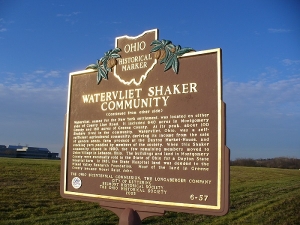Displaying items by tag: Shaker
Watervliet Shaker Village was a Shaker community located in Kettering, Ohio from 1806-1900. Its spiritual name was Vale of Peace and it was within the Union Village bishopric, or governing body. The community was founded by many discontented members of the Beulah Presbyterian church and was named for the first Shaker community in the United States, Watervliet Shaker village in New York. The village at its peak had 100 residents, and it spanned 800 acres. It produced and sold farm produce, garden seeds, and stocking yarn. Among the first Euro-Americans to arrive in this area were John H. Patterson and his family who provided the land on which the Watervliet Shaker Community was founded in 1806.
The village closed in 1900 and the remaining residents moved to the Union Village Shaker settlement in Lebanon, Ohio. The village was sold to the State of Ohio. It was a State Hospital Farm until 1981 when the land in Montgomery County was deeded to the Miami Research Foundation. The land in Greene County had primarily been used for Mount Saint John. Papers, diaries, photographs and books of the village history are archived at the Dayton Metro Library in the 'Shakers Collection'.
https://www.beavercreekliving.com/best-of-beavercreek/itemlist/tag/Shaker#sigProId2f84a7e8f9
Welcome to Shakertown! The Shakers were a religious sect that practiced celibacy, communal living and equality of the sexes in their leadership. The actual name of the sect was The United Society of Believers in Christ’s Second Appearing, but they became known as Shakers due to the energetic dancing included in their worship services. The community, named Watervliet, extended into both Montgomery and Greene counties and was founded by a wheelwright named John Huston.
The Shakers were significant contributors to early American life having invented the circular saw, flat broom and clothes pins. Locally they were respected as hard working, peaceful and sincere people, supporting their commune with produce farming, the packaged seed industry, and Shaker-style furniture. Their 160 acre tract in Greene County was primarily located along County Line Road at the current locations of the Mount St. John / Bergamo Center and the Research Park lands.
Latest Blog Posts
- Just Don't Call Us Late For Dinner...
- Remember When...
- What A Long, Strange Trip It's Been...
- Snow Down = Slow Down
- School Bus Safety - Just Do It!
- Stevenson Road Covered Bridge
- Our Road Crews Are Worth Their Salt!
- The Most Colorful Of Seasons!
- Popcorn Fest! - Then And Now
- Pre-School Paradise!
- Remembering Riffles
- Ten Year Anniversary Of The Beaver Statues







